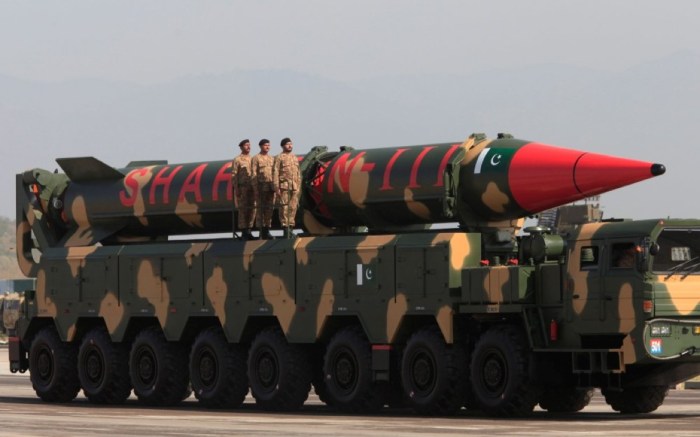
India and Pakistan Go Nuclear: A History of Tension
India and Pakistan go nuclear – a phrase that evokes images of geopolitical tension and the chilling possibility of nuclear war. This story is a complex one, woven with threads of history, ideology, and the ever-present shadow of conflict. It’s a tale that began long before the first bombs were detonated, rooted in the turbulent birth of two nations and the lingering echoes of colonialism.
From the simmering rivalry over Kashmir to the anxieties of a Cold War world, the path to nuclearization was paved with mistrust and fear. This blog delves into the events that led India and Pakistan to this precarious point, exploring the motivations behind their nuclear programs and the implications for the region and the world.
Historical Context
The nuclearization of India and Pakistan is a complex and multifaceted issue with roots deeply embedded in the tumultuous history of the region. The development of nuclear weapons by these two nations is a product of a confluence of factors, including the legacy of colonialism, the rise of Cold War tensions, and the ongoing territorial disputes between the two countries.
The Legacy of Colonialism
The partition of British India in 1947, which led to the creation of India and Pakistan, was a traumatic event that left a lasting impact on the relationship between the two nations. The partition resulted in widespread violence and displacement, and the two countries have been locked in a bitter rivalry ever since.
The nuclear arms race between India and Pakistan in the late 20th century was a stark reminder of the dangers of unchecked power. It also highlighted the ethical dilemmas faced by nations, much like the controversy surrounding the role of pharmaceutical corporations in the AIDS crisis, as documented in this article.
While the nuclear threat has thankfully receded, the complex interplay between political, economic, and ethical considerations continues to shape the world today.
This rivalry was further fueled by the unresolved issue of Kashmir, a region claimed by both India and Pakistan. The partition created a deep-seated mistrust between the two countries, which was exacerbated by the ongoing disputes over Kashmir and other issues.
The Role of the Cold War
The Cold War played a significant role in the nuclearization of South Asia. During the Cold War, both the United States and the Soviet Union were actively seeking to expand their influence in the region. India, initially aligned with the Soviet Union, sought to counter the growing influence of the United States in Pakistan.
Pakistan, on the other hand, saw the United States as a potential ally in its rivalry with India. This rivalry, coupled with the Cold War dynamics, created a climate of fear and suspicion, pushing both countries to pursue nuclear weapons as a means of deterrence.
The 1971 Indo-Pakistani War
The 1971 Indo-Pakistani War was a pivotal moment in the history of the region. The war was triggered by the secession of East Pakistan, which became Bangladesh. The war resulted in a decisive victory for India, which led to the creation of Bangladesh.
The war also had a significant impact on the nuclear ambitions of both India and Pakistan. Following the war, Pakistan began to actively pursue nuclear weapons as a means of deterring India. This was seen as a way to prevent another humiliating defeat.
India, in turn, felt compelled to develop its own nuclear weapons to counter Pakistan’s growing nuclear capabilities. The war also highlighted the fragility of the peace in the region and the potential for escalation of conflict.
Nuclear Tests

The nuclear tests conducted by India and Pakistan have significantly impacted the geopolitical landscape of South Asia and the world. These tests were driven by a complex interplay of factors, including security concerns, regional rivalries, and the desire for international recognition.
India’s First Nuclear Test
India’s first nuclear test, codenamed “Smiling Buddha,” took place on May 18, 1974, at the Pokhran Test Range in Rajasthan. The test was a peaceful nuclear explosion, conducted to demonstrate India’s nuclear capabilities and deter potential adversaries.
“We have exploded a nuclear device. It is a peaceful nuclear explosion. This explosion is a landmark achievement for India’s scientific and technological capability.”
Indira Gandhi, Prime Minister of India, May 18, 1974.
The international community’s reaction was mixed. While some countries, such as the United States and the Soviet Union, expressed concerns and imposed sanctions, others, like France and China, acknowledged India’s right to develop nuclear technology.
Pakistan’s Nuclear Tests
Following India’s 1974 test, Pakistan embarked on its own nuclear weapons program. In 1998, Pakistan conducted six nuclear tests in response to India’s nuclear tests in the same year. The tests were conducted at the Chagai Hills in Balochistan.
“Pakistan has conducted its first nuclear test. This is a momentous occasion for Pakistan and its people. It is a testament to our scientific and technological capabilities.”
Nawaz Sharif, Prime Minister of Pakistan, May 28, 1998.
The international community’s response to Pakistan’s tests was similar to its response to India’s tests. Many countries condemned the tests and imposed sanctions. However, some countries, such as China and Saudi Arabia, supported Pakistan’s actions.
Reactions of the International Community, India and pakistan go nuclear
The international community’s reactions to both India and Pakistan’s nuclear tests were largely driven by concerns about nuclear proliferation and the potential for regional instability. Many countries imposed sanctions on both countries, aimed at deterring future tests and encouraging them to join the Nuclear Non-Proliferation Treaty (NPT).
- United States:Imposed sanctions and condemned the tests, urging both countries to sign the NPT.
- United Kingdom:Expressed concerns about the tests and urged both countries to exercise restraint.
- France:Acknowledged India’s right to develop nuclear technology but condemned Pakistan’s tests.
- China:Supported Pakistan’s actions, arguing that it was a response to India’s nuclear tests.
- Russia:Expressed concerns about the tests but maintained close ties with both countries.
Nuclear Doctrine

Both India and Pakistan possess nuclear weapons and have developed doctrines outlining their strategic use. These doctrines are crucial for understanding the nuclear posture of these nations and the potential for conflict or cooperation in the region.
India’s Nuclear Doctrine
India’s nuclear doctrine has evolved over time, reflecting its changing strategic environment and national security priorities. Key principles of India’s nuclear doctrine include:
- No First Use:India has declared a policy of “no first use” of nuclear weapons, meaning it will not initiate a nuclear attack. This principle is intended to deter potential adversaries and promote regional stability.
- Credible Minimum Deterrence:India aims to maintain a credible nuclear deterrent, sufficient to dissuade any potential aggressor from attacking. This doctrine emphasizes the minimum number of nuclear weapons necessary to achieve this goal.
- Massive Retaliation:In the event of a nuclear attack, India reserves the right to retaliate with overwhelming force. This principle highlights the devastating consequences of nuclear war and underscores the importance of deterrence.
- Non-Proliferation:India supports the goal of nuclear non-proliferation and advocates for a world free from nuclear weapons. This commitment is reflected in its adherence to the Nuclear Non-Proliferation Treaty (NPT) and its efforts to promote nuclear disarmament.
Pakistan’s Nuclear Doctrine
Pakistan’s nuclear doctrine is largely based on the concept of “full-spectrum deterrence.” This approach encompasses both conventional and nuclear weapons and aims to deter any form of aggression against Pakistan. Key tenets of Pakistan’s nuclear doctrine include:
- Deterrence:Pakistan’s nuclear weapons are primarily intended to deter any potential attack, particularly from India. The doctrine emphasizes the importance of a credible nuclear deterrent to ensure Pakistan’s security.
- Flexible Response:Pakistan’s doctrine allows for a flexible response to a nuclear attack, including the possibility of retaliating with a nuclear strike. This flexibility aims to provide Pakistan with a range of options in the event of a nuclear conflict.
- No First Use:While Pakistan has not formally declared a “no first use” policy, it has stated that it will not use nuclear weapons first. However, this stance is subject to certain conditions, such as a conventional attack on Pakistani territory or the use of nuclear weapons against Pakistan.
- Minimum Deterrence:Similar to India, Pakistan aims to maintain a minimum nuclear deterrent, sufficient to deter any potential aggressor. This approach seeks to minimize the risk of nuclear escalation while maintaining a credible deterrent.
Comparison of Nuclear Doctrines
While both India and Pakistan have adopted nuclear doctrines based on deterrence, there are significant differences between their approaches.
| Feature | India’s Doctrine | Pakistan’s Doctrine |
|---|---|---|
| No First Use | Declared policy | Not formally declared, but with conditions |
| Deterrence | Credible minimum deterrence | Full-spectrum deterrence |
| Response | Massive retaliation | Flexible response |
| Non-Proliferation | Strong support | Less emphasis |
Regional Implications: India And Pakistan Go Nuclear
The nuclearization of India and Pakistan has had a profound impact on the relationship between the two countries. The constant threat of nuclear war has created a climate of mistrust and suspicion, making it difficult to resolve their long-standing disputes.
The presence of nuclear weapons has also significantly influenced the dynamics of the Kashmir conflict, creating a new layer of complexity and danger.
The nuclear tests conducted by India and Pakistan in 1998 sent shockwaves across the globe. While the geopolitical landscape shifted dramatically, it’s interesting to consider how these events might have influenced economic cooperation. After all, trade agreements often flourish in regions with relative stability.
Perhaps, if tensions had been lower, we might have seen more progress on initiatives like some regional free trade agreements involving both countries. Ultimately, the nuclearization of the region cast a long shadow, potentially hindering the potential for economic integration and collaboration.
Impact on Indo-Pakistan Relationship
The acquisition of nuclear weapons by both India and Pakistan has had a significant impact on their relationship. The nuclear weapons have created a new dimension to the already tense relationship between the two countries. This has led to a situation of “mutually assured destruction” (MAD), where both countries are aware that a nuclear attack by one would inevitably lead to retaliation by the other, resulting in devastating consequences for both.
The constant fear of nuclear war has created a climate of mistrust and suspicion between the two countries, making it difficult to resolve their long-standing disputes. The presence of nuclear weapons has also led to a significant increase in military spending by both countries, diverting resources from other vital areas like education and healthcare.
Role of Nuclear Weapons in Kashmir Conflict
The Kashmir conflict has been a major source of tension between India and Pakistan since their independence in 1947. The presence of nuclear weapons has added a new layer of complexity and danger to the conflict. Both countries have repeatedly threatened to use nuclear weapons in the event of a major escalation in Kashmir.
The fear of nuclear war has also made both countries hesitant to take any action that could be seen as provocative by the other. This has led to a stalemate in the Kashmir conflict, with neither country willing to make any significant concessions.
Potential for Nuclear Escalation
The potential for nuclear escalation between India and Pakistan remains a serious concern. The two countries have a history of military confrontations, and the presence of nuclear weapons has increased the risk of a major conflict. There have been several instances in the past where tensions between the two countries have escalated to the point of a nuclear war.
For example, the Kargil War in 1999, the 2001 Parliament attack in India, and the 2008 Mumbai attacks in India. These incidents have highlighted the fragility of the nuclear peace between the two countries and the need for continued dialogue and diplomacy to prevent a nuclear war.
International Response

The international community reacted strongly to India and Pakistan’s nuclear tests, expressing deep concern and condemnation. The tests triggered a wave of diplomatic efforts, sanctions, and international pressure aimed at preventing further nuclear proliferation in the region and beyond.
United Nations Response
The United Nations Security Council (UNSC) condemned the nuclear tests in strong terms. Resolution 1172 (1998) expressed “grave concern” and “serious condemnation” of the tests, demanding that India and Pakistan “refrain from any further nuclear tests.” The UNSC also called for the two countries to sign the Comprehensive Test Ban Treaty (CTBT), which prohibits all nuclear explosions.
The 1974 and 1998 nuclear tests by India and Pakistan, respectively, were watershed moments in South Asian history. These events sparked global anxieties and fueled the arms race in the region. While the world grappled with the implications of these tests, protests erupted in Washington D.C.
against the IMF and World Bank, highlighting the perceived role of these institutions in exacerbating global inequalities. The nuclear tests, however, underscored the complex geopolitical realities of the region, where national security and economic development remained intertwined.
The UN’s response highlighted the global concern over the proliferation of nuclear weapons and emphasized the importance of international cooperation in preventing their spread.
Sanctions and Diplomatic Measures
Several countries imposed sanctions on India and Pakistan following their nuclear tests. These sanctions included economic penalties, arms embargoes, and restrictions on financial transactions. The United States, Japan, and other countries suspended aid and imposed trade restrictions. The European Union also imposed sanctions, including travel bans on key officials.
These measures aimed to deter future nuclear tests and to pressure the two countries to comply with international non-proliferation norms.
Arms Control and Disarmament
The nuclear arsenals of India and Pakistan pose a significant threat to regional and global security. Despite their rivalry, both countries have engaged in various efforts to control and reduce their nuclear weapons, recognizing the potential for catastrophic consequences.
Challenges and Opportunities for Nuclear Non-Proliferation
The nuclear non-proliferation regime faces significant challenges in South Asia. Both India and Pakistan are not signatories to the Nuclear Non-Proliferation Treaty (NPT), which is considered the cornerstone of the international nuclear order. This absence underscores their commitment to maintaining their nuclear capabilities.
The two countries have also been criticized for their lack of transparency regarding their nuclear programs.Despite these challenges, there are also opportunities for promoting nuclear non-proliferation in the region. The establishment of a South Asian Nuclear-Weapon-Free Zone (SAWNFZ) has been a long-standing goal, but progress has been hampered by political tensions and mistrust.
Nevertheless, the concept of a SAWNFZ offers a framework for regional nuclear disarmament and could contribute to reducing the risk of nuclear conflict.
Public Perception
The public perception of nuclear weapons in India and Pakistan is a complex and multifaceted issue, shaped by a confluence of historical, political, and social factors. While the presence of nuclear weapons has undoubtedly brought a sense of security and national pride, it has also fostered anxieties about potential threats and the devastating consequences of nuclear war.
This section delves into the public perception of nuclear weapons in these two countries, exploring how these weapons have impacted the lives of ordinary citizens and the role of media and public opinion in shaping nuclear policy.
Impact on Ordinary Citizens
The impact of nuclear weapons on the lives of ordinary citizens in India and Pakistan is both tangible and intangible. On the one hand, the existence of nuclear weapons has created a sense of insecurity and fear among the populace, particularly in border regions.
The constant threat of nuclear war hangs over the heads of ordinary citizens, making them vulnerable to the potential devastation of a nuclear attack. The fear of nuclear war has also had a profound psychological impact on people, creating a climate of anxiety and uncertainty.On the other hand, the presence of nuclear weapons has also contributed to a sense of national pride and security.
The nuclear tests conducted by both countries were seen as a symbol of their growing power and influence on the world stage. This sense of pride has been further amplified by the government’s emphasis on the role of nuclear weapons in deterring external aggression and safeguarding national interests.






